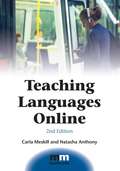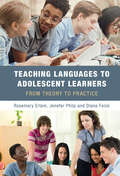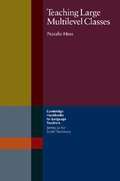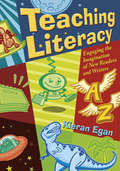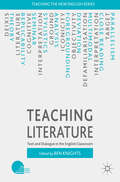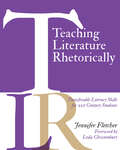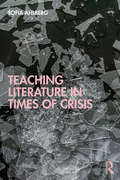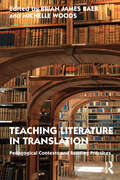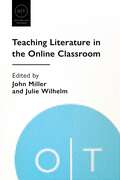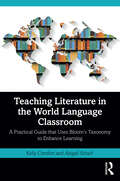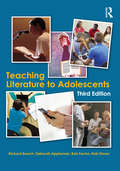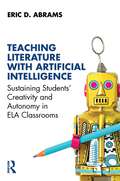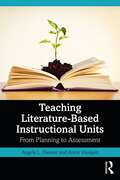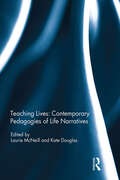- Table View
- List View
Teaching Languages Online
by Carla Meskill Natasha AnthonyNovice and experienced educators who have considered moving some or all of their language courses online will find this text an invaluable starting point and resource throughout the process. In non-technical prose with emphasis throughout on excellence in pedagogical practice, the text takes both the new and experienced language instructor through the nuts and bolts of online teaching practices and uses multiple examples of online instructional conversations to illustrate these practices. Teaching in asynchronous written, asynchronous aural, synchronous written, synchronous aural and combinations of these environments are discussed and exemplary practices provided for each. An excellent place to both begin and augment language teaching online.
Teaching Languages to Adolescent Learners: From Theory to Practice
by Jenefer Philp Rosemary Erlam Diana FeickTeaching languages to adolescents can be a challenge. . . but one that is most rewarding! What works? What doesn't work? This book provides a reader friendly overview on teaching modern languages to adolescents (Years 7–13). Each chapter takes an aspect of language teaching and learning, and explains the underlying theory of instructed language acquisition and its application through examples from real language classrooms. The book explores teachers' practices and the reasoning behind their pedagogic choices through the voices of both the teachers themselves and their students. At the same time, it highlights the needs of the adolescent language learner and makes the case that adolescence is a prime time for language learning. Written in an accessible, engaging way, yet comprehensive in its scope, this will be essential reading for language teachers wishing to integrate cutting-edge research into their teaching. This title is also available as Open Access on Cambridge Core at 10.1017/9781108869812
Teaching Large Multilevel Classes
by Penny Ur Natalie HessThis book provides practical advice for teachers who work with large, mixed-ability classes. It offers a wide variety of activities to develop student motivation, interest, participation and responsibility.
Teaching Late-Twentieth-Century Mexicana and Chicana Writers (Options for Teaching #53)
by Elizabeth Coonrod MartínezMexicana and Chicana authors from the late 1970s to the turn of the century helped overturn the patriarchal literary culture and mores of their time. This landmark volume acquaints readers with the provocative, at times defiant, yet subtle discourses of this important generation of writers and explains the influences and historical contexts that shaped their work.Until now, little criticism has been published about these important works. Addressing this oversight, Teaching Late-Twentieth-Century Mexicana and Chicana Writers starts with essays on Mexicana and Chicana authors. It then features essays on specific teaching strategies suitable for literature surveys and courses in cultural studies, Latino studies, interdisciplinary and comparative studies, humanities, and general education that aim to explore the intersectionalities represented in these works. Experienced teachers offer guidance on using these works to introduce students to border studies, transnational studies, sexuality studies, disability studies, contemporary Mexican history and Latino history in the United States, the history of social movements, and concepts of race and gender.
Teaching Literacy Effectively in the Modern Classroom for Ages 5–8: A Practical Guide for Teaching Reading and Writing in Diverse Learning Environments
by Tom Nicholson Sue DymockDesigned as a “one stop shop” for classroom teachers, this book covers assessment, planning, and progression of writing, spelling, decoding, vocabulary, and comprehension to expand the teaching toolbox.Dymock and Nicholson explore major focus areas in literacy instruction for teachers based on data-driven research advances. They provide the teacher a handy reference manual to consult when designing lessons to teach young children from diverse backgrounds to help them read and write for success. A general discussion of the research literature is built into the structure of the book to give teachers a knowledge base to teach and explain to children the why and the how of what they are learning. The chapters cover recent concepts of structured literacy, including systematic teaching of decoding skills, vocabulary, comprehension, writing, and spelling. This practical guide uses a scope and sequence approach to teaching that gives children a solid foundation of reading and writing skills. The resources and lesson ideas will engage diverse groups in a classroom, including those at risk of literacy difficulties such as dyslexia, so they also can achieve typical achievement levels for their age – and beyond. Containing a wealth of resources and tips for teaching children ages 5–8, alongside easily downloadable lesson plans, hand-drawn charts, and posters, this book will be of great interest to all classroom teachers involved in teaching literacy.This resource-filled book will appeal to teachers, professionals, and researchers in teacher training, with a focus on the needs of the teacher, providing practical and insightful ways to teach effectively in diverse classroom settings.
Teaching Literacy in Early and Middle Childhood
by Karen Loman Angela Danley Natalie TyeTeaching Literacy in Early and Middle Childhood provides pre-service and practicing teachers with effective strategies for teaching English Language Arts. Filled with suggestions that can immediately be put to use, the anthology focuses on supporting the successful implementation of English Language Arts standards. Featuring topics such as vocabulary instruction, teaching phonemic awareness, fostering comprehension, and the use of graphic organizers and visual strategies, each chapter of the book gives the reader a deeper understanding of specific literacy content. The readings are framed by original introductions and learning activities that support content comprehension. Readers who follow the suggested before, during, and after reading activities will benefit from complete immersion into the material. The second edition features updated chapter introductions and seven new readings that explore phonics and mediated word identification, various approaches to teaching reading comprehension, the benefits of assisted reading, building English language learners' academic vocabulary, and more. Teaching Literacy in Early and Middle Childhood combines practical and theoretically sound instruction strategies for literacy with learning activities for educators. Designed as a supplement for standard textbooks, the anthology is well-suited to courses in K-6 education, English instruction, and reading.
Teaching Literacy in Troubled Times: Identity, Inquiry, and Social Action at the Heart of Instruction (Corwin Literacy)
by Peter Smagorinsky Allison Skerrett"Upending deficit narrative of learning loss, combating broken approaches to racial equity, and wading deep into the contested waters of democratic principles of learning within today’s schools, Dr. Skerrett and Dr. Smagorinsky offer an accessible guidebook for making our classrooms sites of justice and joy. Perhaps most importantly, theirs is a book that reveals classroom practices as they really are--the voices of teachers are situated as co-authors in this important journey. I cannot think of a more timely or relevant book for English educators than Teaching Literacy in Troubled Times." — Antero Garcia, Ph.D., Associate Professor, Graduate School of Education, Stanford University Relevant instruction to move education forward instead of "back to normal" Educators often bemoan the so-called learning gap that followed the upheaval to schooling in 2020, but the real learning gap will occur if the watershed events and social shifts of the early 2020s are not integrated into school instruction and learning. For today’s learning to be relevant to today’s students, it must reflect their lives and the true social worlds they inhabit. But how? Teaching Literacy in Troubled Times empowers educators to engage students in critical thinking, literacy activities, and inquiry to investigate the personal and social issues of pressing importance to today’s middle and high school students. Six units of study, each co-authored by a teacher who road-tested the activities in their own classroom, guide teachers through the process of teaching literacy around the topics of identity, social inequity, global justice, empathy, racism and racial literacy, and conflicting ideas of patriotism. This urgent, timely guide to creating a relevant classroom includes: Instructional methods, content knowledge, and learning activities for each unit that engage students in critical inquiry and social action. Insights and guidance from teachers who put the full unit plans in action with students. Reflection questions to help teachers envision the work in their own classrooms. Templates, rubrics, examples of student work, and other tools that help teachers to plan and implement activities that grow students’ capacity to understand and act in society. Prime your students with the critical thinking, investigative, and communicative skills they need to connect themselves to broader social movements and create a new generation of educated changemakers.
Teaching Literacy in Troubled Times: Identity, Inquiry, and Social Action at the Heart of Instruction (Corwin Literacy)
by Peter Smagorinsky Allison Skerrett"Upending deficit narrative of learning loss, combating broken approaches to racial equity, and wading deep into the contested waters of democratic principles of learning within today’s schools, Dr. Skerrett and Dr. Smagorinsky offer an accessible guidebook for making our classrooms sites of justice and joy. Perhaps most importantly, theirs is a book that reveals classroom practices as they really are--the voices of teachers are situated as co-authors in this important journey. I cannot think of a more timely or relevant book for English educators than Teaching Literacy in Troubled Times." — Antero Garcia, Ph.D., Associate Professor, Graduate School of Education, Stanford University Relevant instruction to move education forward instead of "back to normal" Educators often bemoan the so-called learning gap that followed the upheaval to schooling in 2020, but the real learning gap will occur if the watershed events and social shifts of the early 2020s are not integrated into school instruction and learning. For today’s learning to be relevant to today’s students, it must reflect their lives and the true social worlds they inhabit. But how? Teaching Literacy in Troubled Times empowers educators to engage students in critical thinking, literacy activities, and inquiry to investigate the personal and social issues of pressing importance to today’s middle and high school students. Six units of study, each co-authored by a teacher who road-tested the activities in their own classroom, guide teachers through the process of teaching literacy around the topics of identity, social inequity, global justice, empathy, racism and racial literacy, and conflicting ideas of patriotism. This urgent, timely guide to creating a relevant classroom includes: Instructional methods, content knowledge, and learning activities for each unit that engage students in critical inquiry and social action. Insights and guidance from teachers who put the full unit plans in action with students. Reflection questions to help teachers envision the work in their own classrooms. Templates, rubrics, examples of student work, and other tools that help teachers to plan and implement activities that grow students’ capacity to understand and act in society. Prime your students with the critical thinking, investigative, and communicative skills they need to connect themselves to broader social movements and create a new generation of educated changemakers.
Teaching Literacy in the Twenty-First Century Classroom: Teacher Knowledge, Self-Efficacy, and Minding the Gap
by Tiffany L. Gallagher Katia CiampaThis book discusses current issues in literacy teacher education and illuminates the complexity of supporting self-efficacious educators to teach language and literacy in the twenty-first century classroom. In three sections, chapter authors first detail how teacher education programs can be revamped to include content and methods to inspire self-efficacy in pre-service teachers, then reimagine how teacher candidates can be set up for success toward obtaining this. The final section encourages readers to ruminate on the interplay among teacher candidates as they transition into practice and work to have both self- and collective- efficacy.
Teaching Literacy in the Visible Learning Classroom, Grades 6-12: Fisher: Teaching Literacy In The Visible Learning Classroom, Grades 6-12 + Fisher: Visible Learning For Literacy (Corwin Literacy)
by Douglas Fisher John Hattie Dr Nancy Frey Marisol ThayreTeach with Optimum Impact Whether through direct instruction, guided instruction, peer-led and independent learning—every student deserves a great teacher, not by chance, but by design. In this companion to Visible Learning for Literacy, Fisher, Frey, and Hattie show you how to use learning intentions, success criteria, formative assessment and feedback to achieve profound instructional clarity. Chapter by chapter, this acclaimed author team helps put a range of learning strategies into practice, depending upon whether your 6–12 students are ready for surface, deep, or transfer levels of understanding.
Teaching Literacy in the Visible Learning Classroom, Grades 6-12: Fisher: Teaching Literacy In The Visible Learning Classroom, Grades 6-12 + Fisher: Visible Learning For Literacy (Corwin Literacy)
by Douglas Fisher John Hattie Dr Nancy Frey Marisol ThayreTeach with Optimum Impact Whether through direct instruction, guided instruction, peer-led and independent learning—every student deserves a great teacher, not by chance, but by design. In this companion to Visible Learning for Literacy, Fisher, Frey, and Hattie show you how to use learning intentions, success criteria, formative assessment and feedback to achieve profound instructional clarity. Chapter by chapter, this acclaimed author team helps put a range of learning strategies into practice, depending upon whether your 6–12 students are ready for surface, deep, or transfer levels of understanding.
Teaching Literacy: Engaging the Imagination of New Readers and Writers
by Kieran EganThis unique approach to teaching core literacy skills offers step-by-step planning frameworks and an appendix of activity ideas to show teachers how to engage students in the process.
Teaching Literature
by Ben KnightsThis book comprises reflections by experienced scholar teachers on the principles and practice of higher education English teaching. In approaching the subject from different angles it aims to spark insights and to foster imaginative teaching. In the era of audit, and the Teaching Excellence Framework it invites teachers to return to the sources of their own teaching knowledge. The shift from a student-centred to a research-centred paradigm has particular implications for a discipline which prides itself on its teaching, and has always had teaching and dialogue at its heart. One which also talks across the tertiary / secondary border to the cognate (though different) subject called 'English' in school. The argument which informs this book, and which is developed in the individual chapters, is that the future of the subject relies not alone upon fostering communities of 'research excellence', but on re-awakening and reviving its pedagogic traditions.
Teaching Literature
by Elaine ShowalterThis book is an inspirational guidebook for all English and American literature teachers in higher education. - Written by leading academic, prolific author, and cultural journalist, Elaine Showalter - Original and provocative reflections on teaching literature in higher education - Encourages teachers to make their classroom practice intellectually exciting - Wide-ranging - covers the practical, theoretical, and methodological aspects of teaching literature - Highly practical - employs real examples from real classes and careers throughout - Draws on 40 years of international teaching experience
Teaching Literature Rhetorically: Transferable Literacy Skills for 21st Century Students
by Jennifer FletcherEnglish language arts teachers often find themselves defending their discipline and the practical values it has. When will I read this again? is an all too common question heard in classrooms. Author Jennifer Fletcher faced the same questions and more. In Teaching Literature Rhetorically: Transferable Literacy Skills for 21st Century Students she shows you how to help your students develop transferable literacy skills that allow them to succeed not just in their English language arts classes, but in their future lives and careers. The book is built around eight high-utility literacy skills and practices that will help students communicate effectively and with confidence as they navigate important transitions in their lives: Integrating skills and knowledge from texts Reading closely and critically Assessing rhetorical situations Negotiating different perspectives Developing and supporting a line of reasoning Analyzing genres Communicating with self and others in mind Reading and writing with passion Teaching Literature Rhetorically offers readers writing prompts, readings, discussion questions, graphic organizers, as well as examples of student work and activities for helping students to understand key rhetorical concepts. As Fletcher writes in her introduction rhetorical thinking promotes the transfer of learning — the single most important goal we can have as teachers if we hope to have a positive impact on our students&’ lives. This book will help teachers everywhere do just that.
Teaching Literature Using Dialogic Literary Argumentation
by George E. Newell David Bloome Matt Seymour Theresa ThanosIntroducing a new framework for teaching and learning literature in secondary schools, this book presents Dialogic Literary Argumentation as an inquiry-based approach to engage students in communicating and exploring ideas about literature. As a process of discovery, Dialogic Literary Argumentation facilitates conversation—"arguing-to-learn"—as a method to support students’ diverse perspectives and engagement with one another in order to develop individual and collective understandings of literature and their place in the world. Covering both the theoretical foundation and application of this method, this book demonstrates how to apply Dialogic Literary Argumentation to teach literature in a way that foregrounds dialogue, learning through inquiry, diverse views, listening to others, and engagement with our communities. Ideal for preservice teachers in literacy methods courses and practicing teachers, it features real-world cases, discussions of the principles presented, resource lists, and conversation starters for professional learning communities, professional development, and teacher education.
Teaching Literature in Times of Crisis
by Sofia AhlbergTeaching Literature in Times of Crisis looks at the range of different crises currently affecting students – from climate change and systemic racism, to the global pandemic. Addressing the impact on students’ ability and motivation to learn as well as their emotional wellbeing, this volume guides teachers toward strategies for introducing both canonical and contemporary literature in ways that demonstrate the future relevance of sophisticated and targeted literacy skills. These reading practices are invaluable for framing and critically examining the challenges associated with crisis in order to help cope with grief and as a means to impart the skills needed to deal with crisis, such as adaptability, flexibility, resilience, and resistance. Providing necessary background theory, alongside practical case studies, the book addresses: Reading practices for demonstrating how literature explores ethical issues in specific and concrete rather than abstract terms Making connections between disparate phenomena, and how literature mobilises affect in individual and collective human lives Supporting teachers in considering new, imaginative ways students can learn from literary content and form in online or remote learning environments as well as face to face Combining close and distant reading with creative and hands-on strategies, presenting the principles of a transitional pedagogy for a world in flux. This book introduces teachers to methods for reading and studying literature with the aim of strengthening and promoting resilience and resourcefulness in and out of the literature classroom and empower students as global citizens with local roles to play.
Teaching Literature in Translation: Pedagogical Contexts and Reading Practices
by Brian James BaerThe teaching of texts in translation has become an increasingly common practice, but so too has the teaching of texts from languages and cultures with which the instructor may have little or no familiarity. The authors in this volume present a variety of pedagogical approaches to promote translation literacy and to address the distinct phenomenology of translated texts. The approaches set forward in this volume address the nature of the translator’s task and how texts travel across linguistic and cultural boundaries in translation, including how they are packaged for new audiences, with the aim of fostering critical reading practices that focus on translations as translations. The organizing principle of the book is the specific pedagogical contexts in which translated texts are being used, such as courses on a single work, survey courses on a single national literature or a single author, and courses on world literature. Examples are provided from the widest possible variety of world languages and literary traditions, as well as modes of writing (prose, poetry, drama, film, and religious and historical texts) with the aim that many of the pedagogical approaches and strategies can be easily adapted for use with other works and traditions. An introductory section by the editors, Brian James Baer and Michelle Woods, sets the theoretical stage for the volume. Written and edited by authorities in the field of literature and translation, this book is an essential manual for all instructors and lecturers in world and comparative literature and literary translation.
Teaching Literature in Virtual Worlds: Immersive Learning in English Studies
by Allen WebbWhat are the realities and possibilities of utilizing on-line virtual worlds as teaching tools for specific literary works? Through engaging and surprising stories from classrooms where virtual worlds are in use, this book invites readers to understand and participate in this emerging and valuable pedagogy. It examines the experience of high school and college literature teachers involved in a pioneering project to develop virtual worlds for literary study, detailing how they created, utilized, and researched different immersive and interactive virtual reality environments to support the teaching of a wide range of literary works. Readers see how students role-play as literary characters, extending and altering character conduct in purposeful ways ,and how they explore on-line, interactive literature maps, museums, archives, and game worlds to analyze the impact of historical and cultural setting, language, and dialogue on literary characters and events. This book breaks exciting ground, offering insights, pedagogical suggestions, and ways for readers to consider the future of this innovative approach to teaching literary texts.
Teaching Literature in the Online Classroom (Options for Teaching #59)
by John Miller and Julie WilhelmThis volume considers the challenges and opportunities of online literature classes and suggests instructional strategies that ensure students are engaged in the virtual classroom. The ideas shared here are grounded in research, practice, critical self-reflection, and collaboration. Reflecting a diverse collection of practical tips and experiences from colleagues teaching at a variety of institutions, the essays offer readers the chance to inhabit others' classrooms. Contributors discuss building an interactive and inclusive classroom and using hypertext, video lectures, and other asynchronous and synchronous tools in classes whose subjects include, among others, Shakespeare, the Chinese novel, early American literature, speculative fiction, and contemporary American poetry.
Teaching Literature in the World Language Classroom: A Practical Guide that Uses Bloom’s Taxonomy to Enhance Learning
by Kelly Comfort Abigail ScharfTeaching Literature in the World Language Classroom presents a five-stage methodology for teaching literature in language curriculum that repurposes Bloom’s original and revised taxonomy to promote the language acquisition process and spark other types of learning. The first step of text selection, preparation, and initiation asks students to: recognize familiar words, structures, and concepts; contextualize the reading; and remember the main details of the text. The second stage of beginning literary analysis gets target-language learners to describe, identify, and understand the basic elements of plot, character, setting, and narration. The third phase of intermediate literary analysis prompts students to interpret, analyze, and examine major themes, key passages, and the overall commentary. The fourth step of advanced literary analysis teaches students to synthesize multiple and conflicting interpretations, compare assigned texts across units or themes, and evaluate works through essay writing. The fifth stage of reflective and creative engagement challenges students to relate the assigned texts to themselves through personal and intercultural reflection, create new artistic works, and produce unique texts in the target language. The concluding chapter showcases all five stages of the methodology by applying them to a sample text, thereby inviting world language educators to assess the potential usefulness of Comfort and Scharf’s approach to their own language courses. This is an ideal resource for world language educators teaching literature as well as undergraduate and graduate education students focusing on target-language literature instruction and its role in the language acquisition process.
Teaching Literature to Adolescents
by Deborah Appleman Rob Simon Richard Beach Bob FechoThis popular textbook introduces prospective and practicing English teachers to current methods of teaching literature in middle and high school classrooms. It underscores the value of providing students with a range of different critical approaches and tools for interpreting texts and the need to organize literature instruction around topics and issues of interest to them. Throughout the textbook, readers are encouraged to raise and explore inquiry-based questions in response to authentic dilemmas and issues they face in the critical literature classroom. New in this edition, the text shows how these approaches to fostering responses to literature also work as rich tools to address the Common Core English Language Arts Standards. Each chapter is organized around specific questions that English educators often hear in working with pre-service teachers. Suggested pedagogical methods are modelled by inviting readers to interact with the book through critical-inquiry methods for responding to texts. Readers are engaged in considering authentic dilemmas and issues facing literature teachers through inquiry-based responses to authentic case narratives. A Companion Website [http://teachingliterature.pbworks.com] provides resources and enrichment activities, inviting teachers to consider important issues in the context of their current or future classrooms.
Teaching Literature with Artificial Intelligence: Sustaining Students' Creativity and Autonomy in ELA Classrooms
by Eric D. AbramsTeaching Literature with Artificial Intelligence explores the use of chatbots as participants in the teaching and learning of literature in high school and college classrooms while highlighting potentially outmoded norms and expectations of ELA instruction. Artificial intelligence programs have profoundly altered the daily realities of teachers and students, inspiring concern and opportunity alike. Thought-provoking, theoretically grounded, and full of replicable autoethnographic experiments, this book offers real-world examples of generative chatbot technologies in ELA classrooms, positioning their accessibility and ubiquity as an incentive for critiquing and enriching traditional teaching and learning approaches. Graduate students, teaching faculty, and scholars of teacher education, English and literature education, digital literacies, and learning design will come away with a sharp critique of the purported affordances of chatbots as well as an incisive demonstration of AI as a classroom tool that supports, rather than diminishes, the meaningful learning, critical thinking, and agentive development of young people today.
Teaching Literature-Based Instructional Units: From Planning to Assessment
by Anete Vásquez Angela L. HansenTeaching Literature-Based Instructional Units: From Planning to Assessment provides an accessible roadmap to planning, designing, and implementing literature-based instructional units for the English Language arts (ELA) classroom. Understanding that unit plans are the building blocks of the ELA curriculum, Hansen and Vásquez outline the theoretical foundations and approaches behind teaching ELA and offer a framework to help readers make sound decisions about their content pedagogy. In so doing, this text offers research-based and straightforward guidance on planning instruction around key literary texts. Placing literature at the center of the ELA curriculum, the approaches in this book not only support students’ reading, writing, listening, speaking, and digital media skills, but will also motivate and inspire them. Part 1 addresses how to choose unit themes and texts, discusses the importance of having a rationale for choices made, and examines the practical, philosophical, and historical approaches to teaching literature. Part 2 provides step-by-step instructions for designing literature-based units of instruction by using backwards design. The text focuses on assessment before moving into how to scaffold and sequence lessons to meet learning objectives, and concludes with consideration given to teaching ELA in virtual environments. The wealth of activities, strategies, exercises, examples, and templates in this book make this text essential reading for instructors and pre-service teachers in ELA pedagogical methods courses and for practicing teachers of literature instruction.
Teaching Lives: Contemporary Pedagogies of Life Narratives
by Kate Douglas Laurie McNeillThe contemporary ‘boom’ in the publication and consumption of auto/biographical representation has made life narratives a popular and compelling subject for twenty-first century classrooms. The proliferation of forms, media, terminologies, and disciplinary approaches in a range of educational contexts invites discussion of how and why we teach these materials. Drawing on their experiences in disciplines including creative writing, language studies, education, literary studies, linguistics, and psychology, contributors to this volume explore some of the central issues that inspire, enable, and complicate the teaching of life writing subjects and texts, examining the ideologies, issues, methods, and practices that underpin contemporary pedagogies of auto/biography. The collection acknowledges the potential perils that life writing texts and subjects represent for instructors, with a series of short essays by leading auto/biography scholars who reflect on their failed experiences teaching life narratives, and share strategies for negotiating the particular challenges these texts can present. Exploring issues including teaching across genres, analyzing writing about trauma, decolonizing pedagogies, and challenging assumptions (our own, our students’, and our colleagues’), Teaching Lives illuminates what makes the teaching of life narratives different from teaching other kinds of subjects or texts, and why auto/biography has such a critical role to play in contemporary education. This book was originally published as a special issue of a/b: Auto/Biography Studies.
